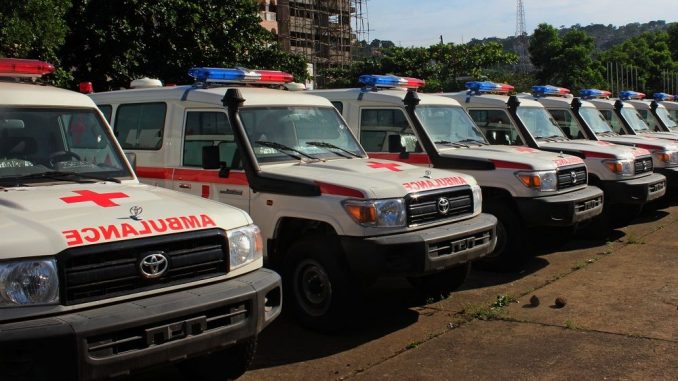
By Victor Ako Mengot
The State Opening of Parliament was indeed a memorable occasion because after a 10-year wait, the Sierra Leone Peoples Party (SLPP) is finally back in power. The President as Head of State spent over 2 hours in the delivery of his ‘State of the Nation’ and to profess his vision for managing the affairs of Sierra Leone according to the priorities in the ‘New Direction’ Manifesto. After the delivery of his address, Members of Parliament will now spend five days debating the issues raised and providing a measured response based on their party’s interest, the concerns of their electorate and their individual interest. The Sierra Leone Parliamentary Watch (SLPW) will also be reviewing some of these issues of concern and will welcome the views of all our subscribers.
The first issue in this series of review is the urgent need for a National Ambulance Service. This is what the President had to say:
“Despite the many donations of ambulances during the outbreak of the Ebola Virus Disease, it is disappointing to note that to date, we do not have a National Ambulance Service. We still do not have a clear number of ambulances. In the next few months, my Government will conclude arrangements for a National Ambulance Service”.
The above statement is also in line with a previous Executive Order which states that:
“With immediate effect, purchase of vehicles by all Ministries, Departments and Agencies (MDAs) and public corporations has been banned until a new Fleet Management Policy is put in place”.
The UK Department for International Development (DfID) was one of the donors that provided ambulances and other operational vehicles during the Ebola Crisis. As part of its review of the support for the Government during this crisis and before transferring ownership of these vehicles to the Ministry of Health & Sanitation, an International NGO with experience in Fleet Management was commissioned to developed a strategy for managing these vehicles prior to the handing over ceremony.
The Transaid Technical Team conducted fleet management assessments and interviews with 44 stakeholders throughout the country and these were the findings of their review:
• The District Health Management Teams lack the systems, structures and capacity to manage health vehicles effectively
• The majority of stakeholders are averse to the DHMT being given responsibility to maintain and fuel vehicles if a cost-effective alternative can be found
• The SMART Alliance and Handicap international have illustrated that with the necessary funding and expertise large fleets of vehicles can be effectively managed in Sierra Leone
• There is currently little basis on which to calculate health vehicle demand be it from an operational perspective or a public health priority perspective
• Concurrent to this assignment a number of stakeholders are working towards the design and implementation of a National Ambulance Service.
These findings were made known to the DfID office in Sierra Leone as well as the beneficiaries – Ministry of Health and Sanitation (MOHS). The MOHS, at the time was keen to act on these recommendations and several attempts were made to bring in the necessary expertise from abroad to fully implement a National Ambulance Service. What was lacking was the strategic direction including the local partnership involvement, and the need to implement the project based on a tried and tested approach focusing on a pilot study in selected Districts.
A Strategic Approach to the Development of a National Ambulance Service
Change Management
In order to develop a fully functional National Ambulance Service, the new government needs to develop a proper heath transport management and logistics system to cover all aspects of service delivery including that of the proposed National Ambulance Service covering every District in the Country. This can be done through a reiterative approach with the identification of two pilot areas for the implementation of a fully functional District Health Transport Management System (TMS).
The development of the district-based TMS is very much concerned with the effectiveness and efficiency of transport utilization – increasing the coverage and reducing the costs, conscious that expenditure is then released for other health delivery activities. In the planning of this strategy, attention should be given to the need to develop and agree key performance indicators, and the established target values that have been developed elsewhere in Africa to provide simple but vital management information to monitor and improve performance and clearly guide transport budgeting and accounting.
Central to this approach will be the need to improve the skills and knowledge of health administrators and operational staff (i.e. drivers and motorcycle riders) on the systems and processes for effectively managing the available transport resources.
Training Programme for Health Administrators/Personnel
– Health & Safety at Work
– Accident Prevention Techniques
– Transport Management Operational Guidelines
– Basic Driver & Motorcycle Training
– Planned Preventive Vehicle Maintenance and Training of Mechanics
The rationale of this approach is that the efficiency of the Provincial and District Health Management Teams to effectively manage the use of transport resources would grow with the clarity of understanding of the roles and responsibilities of individuals. Therefore, the initial training must be focused on improving the transport management skills of health administrators as `drivers of change’ with the expectation that they would promote co-ordination between different stakeholders and foster a culture of shared responsibility.
Human Resource Development
It will not be possible to sustain or indeed improve the performance of a National Ambulance Service (NAS) to required levels without investment in the workforce by training more paramedics and expanding the intermediate care service to increase emergency ambulance availability. The development of a modern, fit-for-purpose and sustainable ambulance service necessitates the ongoing consideration of alternative service models and approaches to the delivery of pre-hospital care (for example, it may prove not to be necessary to transport all patients to an emergency department or an acute hospital and the skills and expertise of highly trained ambulance staff may be used differently).
The move from emergency medical technicians to paramedics crewing emergency ambulances and the introduction and expansion of the cohort of advanced paramedics capable of giving advanced emergency care will significantly augment the level of clinical care that the NAS is capable of delivering. This capability will continue to develop and will enable the NAS to trial and implement alternative care pathways.
Information and Communications Technology
It must be widely accepted that effective stakeholder interactions are the key to successful change delivery. One of the key challenges the ICT function will face will be to prioritize the needs of the various internal and external stakeholders so that they all feel they have the right level of exposure in relation to the ICT strategy deliverables.
The effective delivery of this strategy will be achieved by structured and proactive stakeholder engagement (both internal and external). The establishment of an ICT Strategic Steering Group with appropriate representation from Clinical, District Health Management Teams and Operational management (ambulance crew), should bi-annually review the changing technology landscape against the National Ambulance Services’ ICT principles and objectives.
The ICT Strategy must aim to ensure that information is recorded once, at the first point of contact and shared securely with patients, hospital administrators and other care providers where the need arises. In terms of direct ambulance patient care and care pathways, this will often mean treatment closer to the patient’s home with clear links and sign-posting to primary and secondary services and health information.
Moreover, the development of a Communication system (internet-based system for monitoring caller responses and link to national emergency response (e.g. 999 or 911) as the case maybe; setting up a vehicle tracking system using GPS and/or mobile technology to monitor vehicle operation; setting up Radio Communications systems in remote location without mobile phone coverage and linking them to the communications network are all essential elements of a fully integrated ICT system for the NAS.





